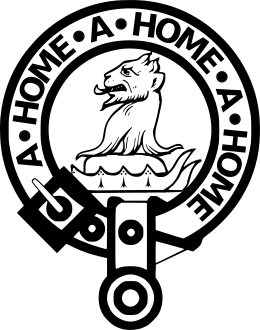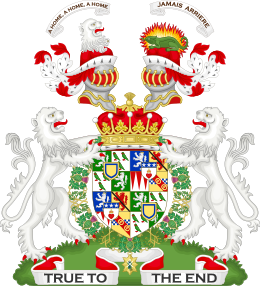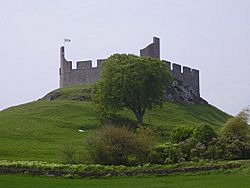Clan Home facts for kids
Quick facts for kids Clan Home |
|||
|---|---|---|---|
 |
|||
| Motto | True to the End | ||
| Slogan | A Home, A Home, A Home | ||
| Profile | |||
| Region | Borders | ||
| District | Berwickshire | ||
| Plant badge | Broom | ||
| Chief | |||
 |
|||
| Michael David Alexander Douglas-Home, 16th Earl of Home | |||
| Earl of Home | |||
| Seat | The Hirsel | ||
| Historic seat | Hume Castle Fast Castle |
||
|
|||
|
|||
Clan Home (pronounced and sometimes spelled Hume) is an old and powerful Scottish clan. For a long time during the Middle Ages, they were very important. They controlled the eastern part of the Scottish Borders. Many leaders from Clan Home served as Wardens of the Eastern March. They had more Wardens than any other family!
Contents
History of Clan Home
How the Clan Began
The Home family comes from a person named Cospatric I. He lived a very long time ago, before 1073. He was an Earl in Northumbria. Later, in the 1200s, a man named William de Home got land in Home, Berwickshire. He married his cousin Ada, who was the daughter of Patrick I, Earl of Dunbar. Because of this marriage, William took the surname Home.
William's family symbol was a silver lion. It was like the Dunbar family's symbol, but on a green background. This green color was a nod to his lands in Greenlaw.
In the 1300s, Sir Thomas Home married Nichola. She was the heir to the Pepdies of Dunglass. This marriage brought the Homes more land in Dunglass. They built the Collegiate Church of Dunglass there, which you can still see today. The Homes also started adding the Pepdie family's symbols to their own. These were three green "papingoes," or parrots, on a silver background. This was one of the first times in Scotland that two family symbols were combined like this.
Sir Thomas and Nicola had two sons. The older son, Alexander, became the chief of the family. The younger son, David, started an important branch of the family, the Homes of Wedderburn.
The 1400s

In 1402, Sir Alexander Home was captured at the Battle of Homildon. Later, he went to France with the Earl of Douglas. He was killed in a battle there in 1424. Most of the main branches of the clan came from his three sons.
In 1473, Alexander's great-grandson became a very important person. He was made the Great Chamberlain of Scotland and the Warden of the Marches. He also became a Lord of Parliament, known as Lord Home. He joined Prince James' rebellion against his father, King James III. He played a big part in the Battle of Sauchieburn, where the king died.
The 1500s
In 1513, the 3rd Lord Home and his men joined King James IV's army. They went to invade England. Lord Home led the Scottish knights at the Battle of Flodden. He was lucky to survive, but many of his family and supporters did not.
Later, Lord Home was chosen to advise the Queen Regent. But things changed when the Duke of Albany took over the regency. Lord Home was arrested. He was accused of working with the English. He and his brother were executed in October 1516. Their heads were put on display at Edinburgh Tolbooth.
The family's title and lands were later given back to another brother, George Home. George Home often led his Border spearmen against the English. Sadly, he fell from his horse and died from his injuries. This happened just before the Battle of Pinkie Cleugh in 1547. The English took over the Home family's lands. However, Lord Home's son, the fifth Lord, took them back in 1549. He also supported the Scottish Reformation. He was part of the Parliament in 1560 that passed the Protestant Confession of Faith.
During the time of Mary, Queen of Scots, the Homes changed who they supported more than once. Lord Home had supported Mary's marriage to the Earl of Bothwell. But later, he led his men against the queen at the Battle of Langside. Then, in 1573, he was arrested. He was found guilty of acting against the young King James VI of Scotland. He was let out of Edinburgh Castle only after he became very sick. He died a few days later. His son, Alexander, the sixth Lord Home, was very loyal to James VI. He served as an ambassador to France many times.
The 1600s and Civil War

When James VI of Scotland went to England in 1603, he became James I of England. He stopped at Dunglass Castle. Lord Home went with him to London. In March 1605, Lord Home was given the title of Earl of Home.
The third Earl of Home was a strong supporter of King Charles I. In 1648, he was a colonel in the Berwickshire Regiment of Foot. In 1650, when Oliver Cromwell invaded Scotland, he made sure to capture Home's castle. It was then used by Parliament's soldiers.
The 1700s and Jacobite Risings
The Homes also changed sides during the Jacobite risings in the 1700s. During the Jacobite rising of 1715, the seventh Earl of Home was held in Edinburgh Castle. His brother, James Home of Ayton, lost his lands because he was part of the rebellion.
During the Jacobite rising of 1745, the eighth Earl of Home joined the British government forces. He was with Sir John Cope at Dunbar. He later fought in the Battle of Prestonpans. The Earl became a Lieutenant General. He was made Governor of Gibraltar, where he died in 1761.
Henry Home, Lord Kames was a famous lawyer in the 1700s. He wrote important books about Scots law that are still respected today. David Hume was one of the most respected British philosophers of the 1700s.
The 1900s
The Home family became very well known in the 1900s. The fourteenth earl, Alec Douglas-Home, gave up his noble title. He did this so he could become Prime Minister of the United Kingdom. However, his heirs can bring the title back. The Prime Minister's brother was William Douglas-Home. He was a famous writer and playwright.
Clan Chief
The current chief of Clan Home is Michael, the 16th Earl and Lord of Home. He is also Lord of Dunglass and Baron Douglas. His father, David Douglas-Home, was the previous clan chief.
Castles and Homes
- Hume Castle was the first main home of the Clan Home chiefs.
- The Hirsel is where the Earls of Home live now.
- Marchmont House, Berwickshire
- Fast Castle, Berwickshire
- Wedderburn Castle, Berwickshire, is the home of an important branch of the family, Home of Wedderburn.
- Paxton House, Berwickshire
- Hutton Castle, Berwickshire
- Ayton Castle, Berwickshire
- Moray House, Edinburgh, was built in the 1620s by the Countess of Home.
- Dunglass Castle, East Lothian
- Manderston, Berwickshire
- Blackadder House, Berwickshire
- Kimmerghame House, Berwickshire
- Redbraes Castle, Berwickshire
- Bassendean House, Berwickshire
- Thornton Castle, East Lothian
Military Connections
A British Army unit, The 40th Regiment Royal Artillery (40 Regt RA), had a long connection with Clan Home. This regiment, also known as The Lowland Gunners, used the Home tartan on parts of their uniform. Every officer and soldier wore a Home Tartan rank slide. Officers also wore Home Tartan trews (trousers) with their dinner jackets. The Regimental Pipes and Drums also wore Home tartan kilts and trews.
In 2009, the regiment moved to Lisburn, Northern Ireland. They named their new technical buildings 'Home Lines'. General Sir Timothy Granville-Chapman officially opened them in 2010. Senior members of Clan Home were there. The Commanding Officer's house was also named 'Home House'. This name sometimes confused people later who didn't know how "Home" was pronounced or about the link between the regiment and the clan! After 40 Regt RA was no longer active, some of the Home connections were passed to another Scottish regiment of the Royal Artillery, 19th Regiment Royal Artillery. They continue these traditions today.
See Also
- Scottish clan
- Home baronets
- Hume baronets
- Earl of Home

